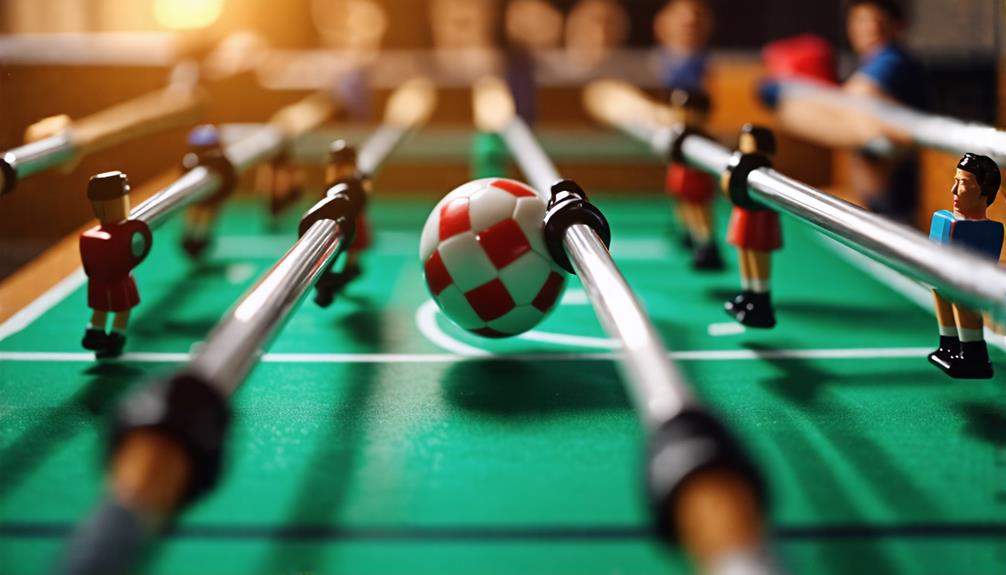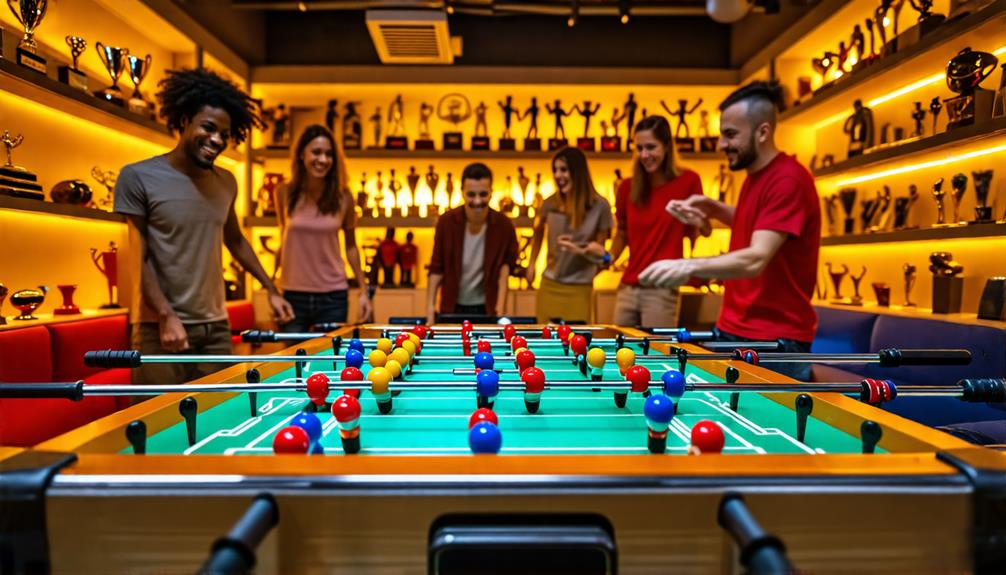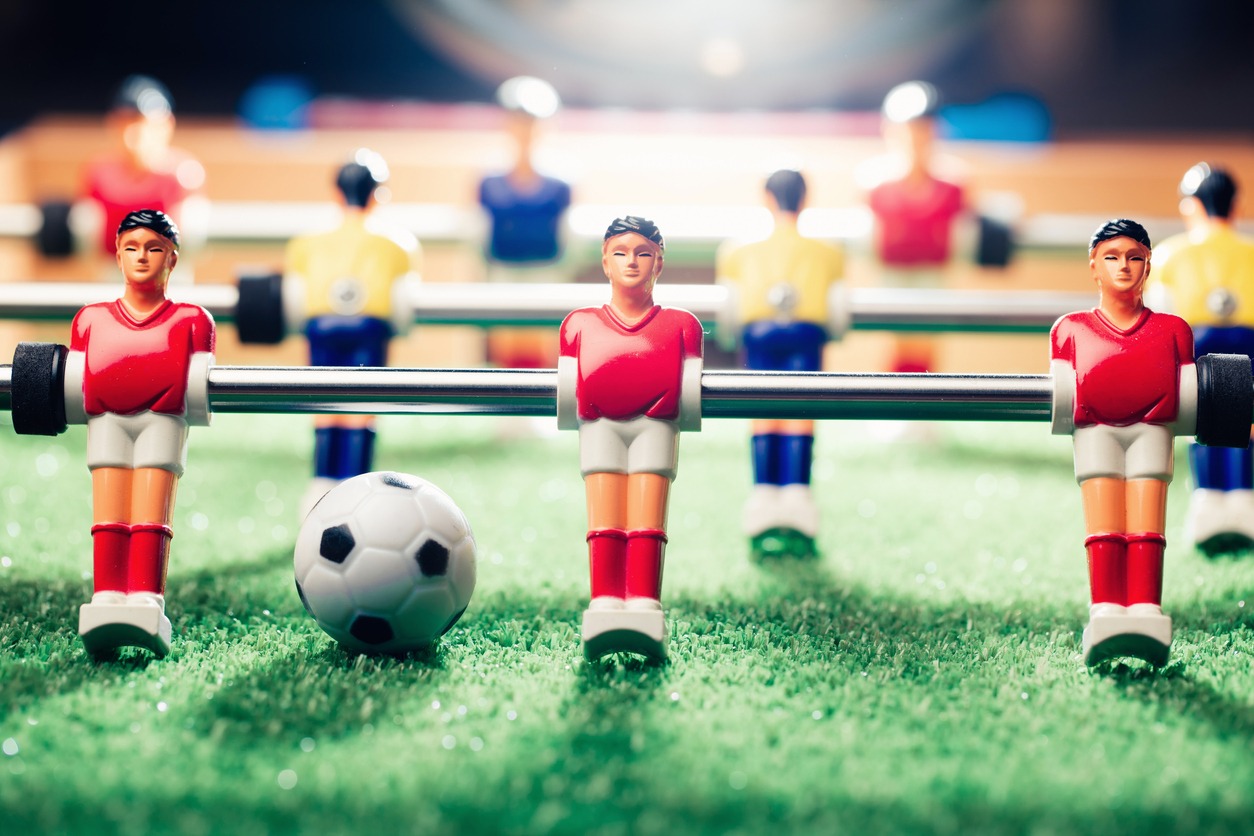Foosball vs. Air Hockey: Which Is Better for Your Home Game Room?
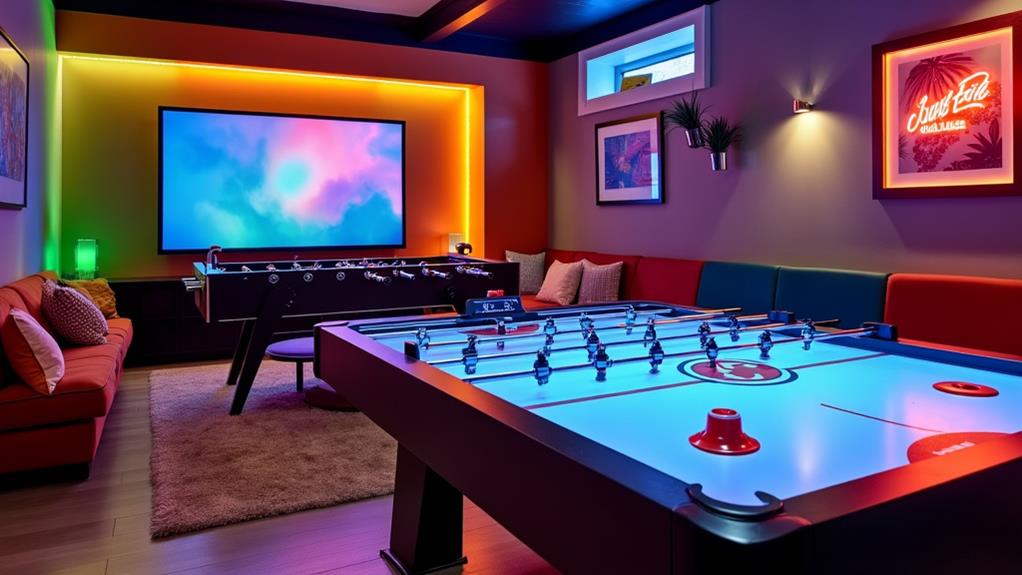
Choosing between foosball and air hockey for your home game room depends on your preferences and needs. Foosball offers tactical team play and accommodates more players, fostering social interaction, while air hockey delivers fast-paced, intuitive gameplay suited for quick one-on-one matches. Foosball tables are generally more compact and easier to maintain, whereas air hockey tables require more space and can have higher upkeep costs. Consider your space, maintenance willingness, and the social dynamic you desire. If you're curious about more detailed considerations and which game might best fit your home setup, keep exploring.
Gameplay Experience
When comparing the gameplay experience of foosball and air hockey, each game brings its own unique flavor to the table. Foosball's gameplay involves miniature players on rods, allowing you to execute tactical maneuvers and engage in team play. This makes it incredibly fun to play, especially when you have a knack for strategy and skillful control. With the option for mixed teams and a four-player format, foosball adds another layer of excitement and engagement to your game room.
On the other hand, air hockey's gameplay is all about fast-paced action. The puck glides on a cushion of air, turning your matches into thrilling one-on-one showdowns. This game is perfect if you love quick reflexes and intense competition. Air hockey is often simpler and more accessible for beginners, making it easier for anyone to jump in and start having fun.
Both games have their merits; foosball is ideal for those who enjoy a bit more complexity and teamwork, while air hockey caters to fans of fast reflexes and straightforward gameplay. Ultimately, both are fun to play and can bring endless hours of entertainment to your home game room.
Social Interaction
Social interaction plays a fundamental role in the enjoyment of both foosball and air hockey, but foosball has a distinct edge in fostering group dynamics. When you gather around a foosball table, you can form teams of two, making it a fantastic activity for enhancing camaraderie and cooperation. This team-based approach encourages everyone to work together, strategize, and celebrate each other's successes, creating a lively social atmosphere.
In contrast, an air hockey table mainly accommodates two players at a time, which can limit the level of social engagement. While the fast-paced nature of air hockey is thrilling, it often leads to intense one-on-one competition rather than collaborative social experiences. This can make air hockey less inclusive in group settings.
Many families find themselves gravitating towards foosball tables for regular play, showing a preference for social gatherings centered around this game. The four-player format of foosball increases engagement and interaction, making it a popular choice for parties and group events. So, if you're looking to foster a dynamic and inclusive social environment in your home game room, a foosball table might just be the perfect enhancement.
Skill Requirements

Skill requirements differ considerably between foosball and air hockey, influencing how quickly players can pick up each game. If you're considering foosball, be prepared for a steeper learning curve. This game demands effective control of the rods, mastering several techniques for ball control, and strategic positioning. Inexperienced players might find it challenging to counter opponents, requiring quick reflexes and keen anticipation. However, once you get the hang of it, foosball offers a rewarding experience, especially in team play, which can improve social dynamics.
On the other hand, air hockey is generally easier for beginners. Its focus on swift puck movements and straightforward gameplay means that you can grasp the mechanics almost instantly. The fast-paced nature of air hockey allows novice players to jump right into the action, often leading to immediate enjoyment without needing extensive skill development. This makes it an attractive option if you want a game that everyone can play right away without feeling overwhelmed.
Space and Setup
Setting up your game room with either a foosball or air hockey table requires careful consideration of space and setup. Air hockey tables are larger and need dedicated space for airflow, making them less suitable for smaller rooms. They typically measure between 7 to 8 feet in length. On the other hand, foosball tables are more compact, usually around 5 to 6 feet, fitting more easily into different room sizes.
Foosball tables can also accommodate more players, making them great for social gatherings. They support team play, while air hockey is generally limited to two players. This impacts the space dynamics, as more room will be needed around an air hockey table for player movement and puck retrieval.
Additionally, foosball tables often come in folding models, offering versatility in storage and space management. This feature is generally not available with air hockey tables, which can be a significant advantage if you're working with limited space.
Here are three tips to help you optimize space and setup for your game tables:
- Measure your room: Verify you have adequate space, including clearances around the table.
- Consider player count: Think about how many people will be playing at once.
- Look for folding options: If space is tight, a folding foosball table can be a game-changer.
Maintenance and Durability
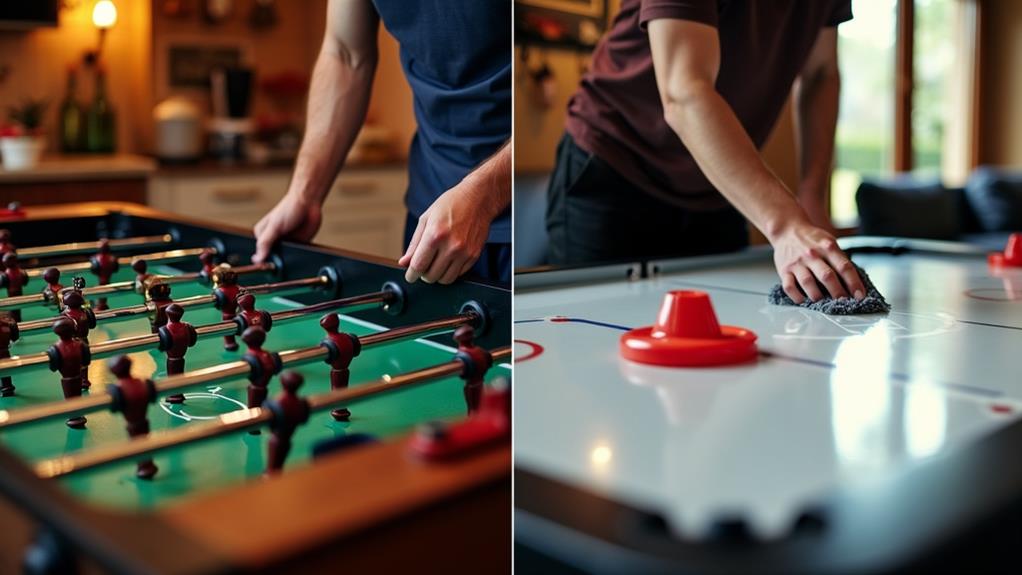
While space and setup are significant considerations, maintaining and ensuring the durability of your game table is also vital. Air hockey tables typically have more moving parts, like blowers and electronic scoreboards, which can lead to increased wear and tear. This often makes them less durable over time compared to foosball tables. You might find yourself dealing with more frequent repairs and parts replacements to keep your air hockey table in top shape.
On the other hand, foosball tables boast a simpler design, making them generally easier to maintain. Regular cleaning is necessary for both tables to prevent issues like beer spills or dirt buildup that can affect gameplay quality. High-quality air hockey tables with robust construction can last longer, but they come with a higher price tag, which might influence your perception of durability.
Foosball tables, while seeing more frequent use, require manageable maintenance, such as occasional replacement of parts like rods or players. This simplicity often translates to fewer headaches and less expense over time. In the end, if ease of maintenance and longevity are top priorities for your home game room, a foosball table might be the better choice.
Popularity and Trends
In recent years, foosball has surged in popularity due to its ability to foster social interaction and team play, making it a favorite for group gatherings. Foosball tables are often the centerpiece of a game room, bringing friends and family together for fun and competition. The durable construction of high-quality foosball tables, like those from Tornado, guarantees they can handle intense gameplay, contributing to their rising popularity.
Air hockey, on the other hand, appeals to those who crave fast-paced action and quick reflexes. However, it typically engages fewer players at a time, which might limit its appeal during larger gatherings. Recent trends indicate that air hockey tables are sometimes repurposed as furniture when not being actively played, whereas foosball tables are consistently used, especially in family settings.
To make the most of your game room experience, consider the following:
- Choose durable foosball tables that can withstand frequent use and energetic play.
- Opt for games that foster group interaction, making gatherings more engaging and fun.
- Keep the layout versatile, guaranteeing both foosball and air hockey can be enjoyed without space constraints.
Age and Family Dynamics

Foosball and air hockey each offer unique advantages regarding development and family dynamics. If you're looking for a game that fosters social interaction and team play, foosball is a strong contender. Families often gather around the foosball table, engaging in weekly matches that include both kids and adults. The mixed-team format allows different age ranges to play together, enhancing family bonds and making it a perfect fit for larger gatherings and events.
On the other hand, air hockey is simpler and easier for beginners, making it particularly appealing to younger children who might struggle with the skills required for foosball. The fast-paced nature of air hockey provides quick, competitive fun, but it's generally limited to two players at a time. This limitation can make it less engaging for larger families or those looking for a more inclusive activity.
While foosball tables are versatile and accommodate larger groups, promoting ongoing family engagement, air hockey tables tend to be enjoyed more as solo or two-player activities. Ultimately, your choice between foosball and air hockey may hinge on if you prioritize inclusive, social gameplay or fast, straightforward fun.
Cost and Value
When considering the cost and value of foosball and air hockey tables, it's clear that both options cater to a range of budgets. Foosball tables typically range from $100 for basic models to over $2,500 for high-end, tournament-quality options. On the other hand, air hockey tables start around $150, with top-tier models costing upwards of $1,200, especially those that feature electronic scoring and advanced airflow systems.
In terms of long-term value, foosball tables often come out ahead. They're more durable and can withstand frequent use with minimal maintenance. This durability translates to better long-term value, ensuring your investment lasts for years. Furthermore, a quality foosball table can improve social dynamics at home, offering continuous engagement and family interaction.
Here are three points to help you decide:
- Cost Range: Foosball ($100-$2,500) vs. Air Hockey ($150-$1,200+).
- Durability: Foosball tables require less maintenance, offering better long-term value.
- Social Engagement: Foosball tables promote group play and family interaction.
While both games have their merits, foosball tends to provide greater long-term entertainment value due to its versatility and durability. Consider your budget and how much value you place on social engagement when making your choice.
